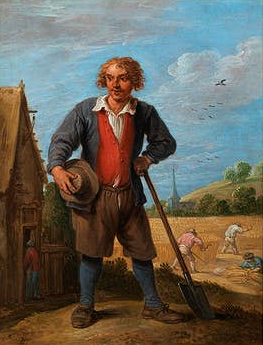David Teniers the Younger - Peasants in a Cornfield
Normaler Preis €24.000 Sparen €-24.000
David Teniers the Younger (Attributed to)
Title: Peasants in a Cornfield (Boer in het veld)
canvas size 9.84 x 7.08 inches (25 x 18 cm)
frame 12.59 x 10.03 inches (32 x 25,5 cm)
signed with monogram lower right: DT F
Provenance:
Stockholms Auktionsverk, 1996-06-03, lotnr. 234, as Attributed to David Teniers II;
Private Collection Sweden;
Uppsala Auktionskammare (Uppsala) 2016-06-14, lot 21, as By David Teniers II (Expertise Marina Aarts);
A Stockholm Collection;
Uppsala Auktionskammare 2021-06, as Attributed to David Teniers II (Expertise Marina Aarts)
RKD Archive:
Nr 19489, as Attributed to David Teniers II - Peasants in a cornfield (Boer in het veld)
Read more
Exhibited:
TEFAF March 2017
Comparable Sales:
Hampel, Germany, Junger Landmann mit Spaten, 25 mar 2021, Price including buyer's premium: € 31,000

Remembering the magic of everyday
life moments in the art of David Teniers
The art of David Teniers the Younger (1610–1690) coincided with the heyday of the Flemish Baroque and captured a great variety of motifs of his time. In this painting of a seemingly simple peasant scene lies keys to understanding both the imaginative mind of Teniers as well as why this time period produced some of the most iconic works in all of art history.
As indicated by the name, Teniers was more or less born into his profession. As the son of David Teniers the elder, himself a painter who studied under Rubens, the younger David received training in art from a very young age and had no less than three brothers who also became painters. Because of his father’s frequent financial failures that even at times saw him imprisoned, David the younger helped to rescue the family from ruin through painting copies of old masters. Essentially, the young Teniers was confronted with painting as both a passion and creative expression as well as a necessity during difficult times, an experience that would shape much of his capacity and sensitivity in his coming life.

Teniers portayed by his colleague Philip Fruytiers in 1655, at the height of his career and dressed in typical Baroque fashion.
Despite the hardships, the talent and determination of Teniers was recognized and quickly expanded his possibilities. He had already spent time in France and possibly also England when he was hired by his father’s former teacher Rubens to help with a prestigious commission with mythological paintings, now considered lost, for Philip IV the king Spain. In 1644–54 Teniers was appointed dean of the Antwerp Guild of Saint Luke, manifesting his esteemed position within the artistic community. A few years afterwards he took an important step when relocating to Brussels, where Teniers yet again found new career opportunities that would prove to be very successful.
As the keeper of the collections of Archduke Leopold Wilhelm, a role similar to what we now refer to as an art advisor, Teniers purchased hundreds of important artworks that manifested the prominent status of the Archduke’s collection while at the same time providing an unusual access to inspiration and knowledge for Teniers himself. Since he kept on painting during the same time, his creative scope must have seemed almost bewildering in the great variety of images and stories that he surrounded himself with.

Archduke Leopold Wilhelm in his Gallery in Brussels, painted by Teniers around 1650. His role as keeper of collections assured him both the budget and permission to create an extraordinary collection of art.
Regardless of how glamorous and culturally stimulating the career of Teniers was, he was as open to the charm and existential importance of everyday life as he was to works of great masters and luxurious collectibles. In his impressive repertoire of genres with everything from exquisite royal portraits, interiors, landscapes and history paintings he always added something new and inventive, highlighting the possibilities of art and importance of an experimental and intuitive mind. It is difficult to single out one aspect or genre to summarize his legacy, since it lies much more in the broad virtuosity across many motifs, although he is particularly remembered for farm scenes and meticulously depicted interiors where other paintings and artworks are captured with an astonishing precision. However, the fact that he is still today one of the most known and celebrated names of the Dutch Golden Age is a proof to the magic of his work, which continues to spark dialogue and wonder in the contemporary viewer of his works.

Detail with church in the background.
We believe in simplicity; Therefore, all orders ship to your door without any additional costs for transport. We use professional shipping companies and pack all orders carefully with special art shipping boxes. All prices on our website include international shipping and transport insurance.

Be aware that you as a customer are responsible for paying any taxes such as import tax in the country of destination (applies to orders outside the EU).















